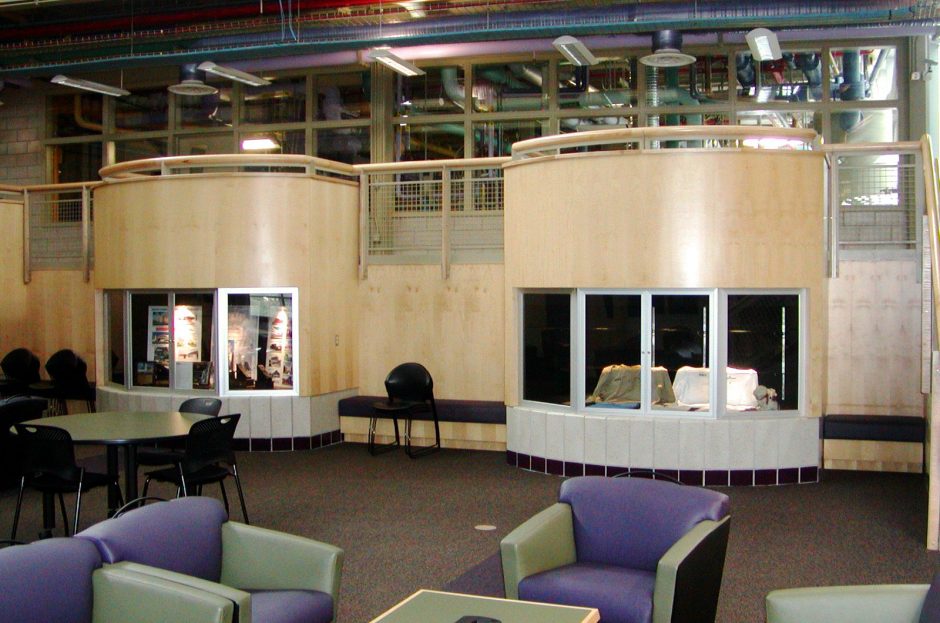

Comparison of name strips, (top) Gummed paper name strip embossed with steel dies, (middle) Engraved name strip of 2 play engraving stock, (bottom) Laser engraved name strip of extruded white acrylic step strip with 3 coats of black paint,
It’s time to order one new name strip for your directory. Did you know that if everything doesn’t match up precisely it will look a little off? Harder for people to read… and a poor reflection on your company.
There’s an art and a science to getting everything just right with Directory Name Strips, and an interesting history, too. Tablet and Ticket was part of the history…a history of perfecting precision.
The Embossed Period
Name strips for building directories started back in 1895 with strips made by brass or steel dies cutting out the letters. It was a lot like setting type. The letters were cut from special paper that had been coated in house with animal glue. Then they were put into a heated press used to set everything. It was tedious, exacting work.
These embossed name strips were available in numerous background and text colors, but no matter how exacting the craftsman was, the embossed strips weren’t as clean as letters available today. Even with careful work, you could often see where the die had punched into the paper. Careful attention was also needed for changing out the name strips when a new employee or business was added. The name strip panel/section needed to be removed, turned over to access and change the strip. In larger cities, there was the option to have the changes and overall maintenance of directories in a service plan.
Following this, name strips progressed to the engraving period.
Engraving Period: Rotary Engraving
Years later, engraving stock was introduced, that combined with steel dies and an odd machine, the pantograph, and a rotary engraving bit, produced a much improved name strip. The engraving stock was typically black face with white behind it so that when engraved, the white name would “pop.” A rotating needle cut away the top surface on the engraving stock to reveal core color beneath. These engraving needles came in different sizes to for different size text. Computerized rotary engraving machines were introduced in the early 1980s. A vast number of typestyles became available at that time. A wide range of background and text colors are offered in this style today.
Obviously, these engraved name strips were faster to set up than the embossed dyes and were more precise. But with rotary engravers, you’d still have some inconsistencies with the fonts. Why?
- Certain letters required multiple passes of the engraving needle. The path of the engraving needles were often visible.
- The stroke, or width, of the characters need to be consistent, due to the close proximity of the namestrips. Engraving needle changes from one order to the next can easily make one strip bolder than another. Tenants often become upset and the directory begins to look unsightly.
Engraving Period: Laser Engraving
Laser cutting has taken away any vestiges of inconsistency for making name strips. The laser beam fires at same point every time and gives unmatched precision.
There have also been changes in the base material for the strips that have resulted in a cleaner look. Extruded acrylic, in either white or black, is now used as the base material. The acrylic is extruded, strips receive 3 coats of special paint, then are cut to precise length, and the laser engraves through the paint to revel the color below. Very fine serifs and details are now possible.
Uniformity of height of strips, size of the margins, exact size, shape and cut of the letters gives a clean professional look for the directory and for your building. And small extras that are standard at Tablet and Ticket help that professional look: painted edges, a shadow line to make it easier for the reader to follow along from the name to the room number, capability to match your current font and strip precisely.
Precision Today
So you have just one name strip to add, or several, or an entire new directory, we can ensure it’s a perfect match. If you’ve ordered with us previously, just send us the name and suite number and we assign you a file. If you’ve never ordered—no problem. Just contact us, send us a sample strip and we can match it precisely. After all, we’ve been doing this for years…






